SOMETHING WICKED THIS WAY COMES - Japanese Stilt Grass Taking Over, Invasion Hits Calhoun
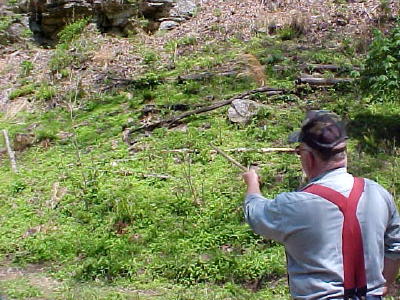
Forrester Russ Richardson points at thousands
of new plants on a steep hillside, with dead
stilt grass covering the ground just above
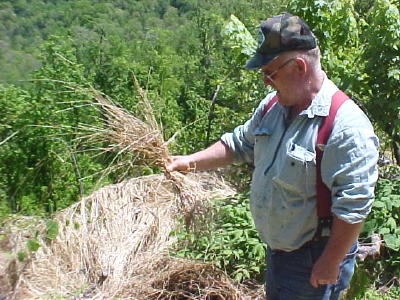
The plant could grow ten feet high, says Richardson,
who says it will burn with the slightest spark
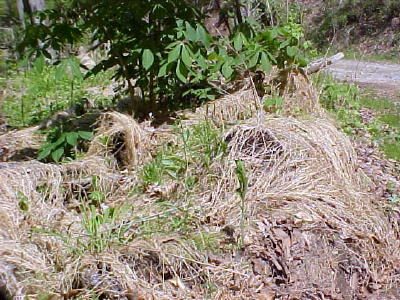
Because it has weak roots, it washes most
anywhere, here caught on rocks and logs beside
Crummies Creek, killing everything underneath
By Bob Weaver 2004
Few people have heard of the silt grass invasion, but the toxic plant has been in Calhoun for eight years and is now present in nearly all West Virginia counties.
Since last year, it is on a growing rampage.
Forester Russ Richardson, who owns a tree farm on the right fork of Crummies Creek, says the rapid growth and climbing nature of this exotic invasive grass has the potential to cause an ecological disaster.
"It could be the likes of which the Appalachian hardwood forest may never recover," he said, making multi-flora rose look like a minor problem.
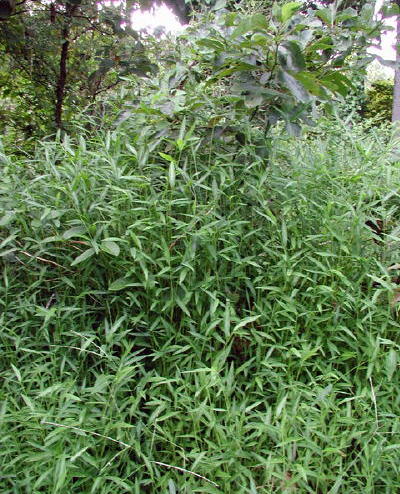
Mature green stilt grass plants
Photo courtesy of Invasive Plant Atlas of New England
Photographer-Leslie J. Mehrhoff
By Bob Weaver (First published 2004)
It kills almost everything underneath it, from valuable plants, flowers and herbs to seedlings for future forests. "It actually gives off a toxic poison," Richardson said.
It is rapidly spreading down the West Fork of the Little Kanawha River and has taken over numerous areas in the region, including Indian Creek in Gilmer and Lewis County.
Richardson said last year's ice storm opened up a lot of sun light to help the seeds grow, in addition to a large amount of rainfall in 2003 and a good growing season.
The grass grows six to eight feet tall, then dies on the ground to smother its victims. Because it has a faint root system, it moves or washes away easily.
"Along Crummies Creek you see it lapped over every log and rock," said Richardson. "It kills everything around it, except its own rebirth." While logged areas help its growth, it can flourish in 95% shade.
Soil and mud transported in and on bulldozers, logging equipment, pickups and ATVs can serve as very effective vectors for spreading stilt grass.
It can also be found up the steep hillsides, several hundred feet above the stream bed.
Japanese stilt grass is not eaten by deer, cattle or even goats.
Stilt grass has no known biological control and specific types of herbicide treatment may be required to get an invasion under control.
Japanese stilt grass (Microstegium vimineum) was brought to this country about 1918 as a "packing grass."
Because each plant produces hundreds of seeds, it can spread quickly.
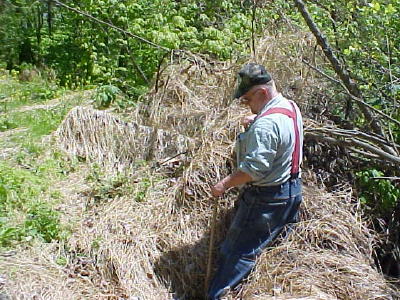
Richardson said it produces a toxic
poison, deadly to every other living plant
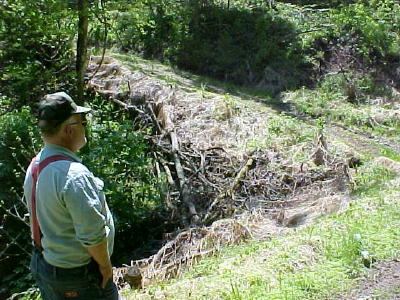
This was a new road built on 2003, now taken over ...
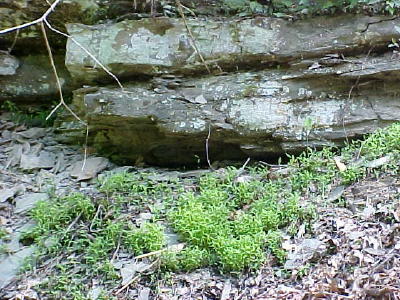
Here the plants are returning along the main
road, last year the grass covered the rock cliff
Stilt grass is recognized during the growing season by its pale green leaves and increasingly common presence in wooded stream bottoms, on logging roads, ATV trails, road banks, power and gas line rights of way and even game trails.
The dead plant becomes a highly flammable brown thatch that quickly ignites. Richardson said it almost "flash burns" and will become a major forest fire threat, particularly with the downed trees from the ice storm.
Stilt grass can now be found in every portion of West Virginia ranging from Fernow Experimental Forest in Tucker County to Cedar Lakes in Jackson County.
"If you do not have Japanese stilt grass on your property, you do not want it and should incorporate an awareness of the long term danger this invasive plant poses to sustainable forestry," said Richardson.
Use SEARCH word "Stilt" for other information